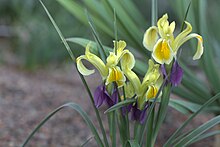|
Iris fosteriana
Iris fosteriana is a species in the genus Iris, subgenus Scorpiris.  It was named after Michael Foster (a known British Iris expert) by Dr Aitchison, and found in Pendjeh, Turkmenistan.[2][3] First described in transactions of the Linnean Society of London in April 1888 and then published by John Gilbert Baker in Botanical Magazine in 1892.[4] Iris fosteriana is an accepted name by the RHS.[5] It has many similarities with other iris species in the Xiphium.[2] HabitIt has a slim bulb (coloured cream) with a long thin neck. Below the bulb are tuberous roots that are white, thin and 6in long.[6] The fragile roots mean that the bulb does not take transplanting very well.[2] In Spring, (March in the UK[2]) it has 1 or 2 long tubed flowers that are 4–5 cm (1.5 or 2in) wide with downward-turned rich purple (or deep purple)[7] standards and creamy yellow (or pale yellow[7]) falls.[8] The flowers do not produce any scent.[2] After flowering, it produces seeds, but there is no aril (coating) on the seed.[6] The seeds are cube-shaped.[9] It has deeply channeled[6] mid-green leaves which have a silver edge.[8] Which start growing in early December. By March, they have turned grey near the base, and mid-green at the tops.[6] They reach between 4-8mm wide and grow up to 18 cm long.[7] The leaves when mature hide the stem.[6] The plant reaches a total height of approximately 10–15 cm tall when in bloom.[7] Best grown in the uk, in an alpine house or bulb frame.[8] NativeFound in the sandy soils of Gulran, Afghanistan, at an altitude of about 4,000 feet.[2] It is also found on the dry steppes (750-2000m above sea level) of North East Iran,[6] near Kopet Dag mountain range.[10] Which also includes the former Russian state of Turkmenistan.[7][11] References
External links
|
||||||||||||||||||||||||||||||||||||
